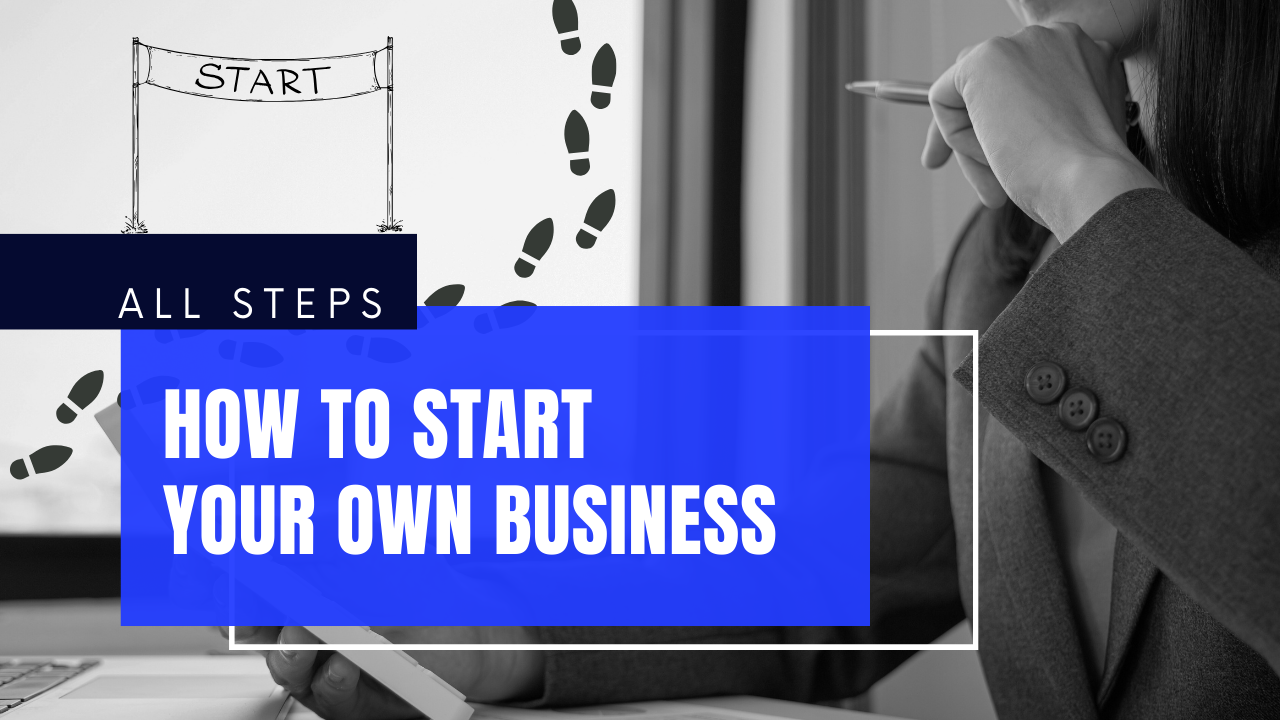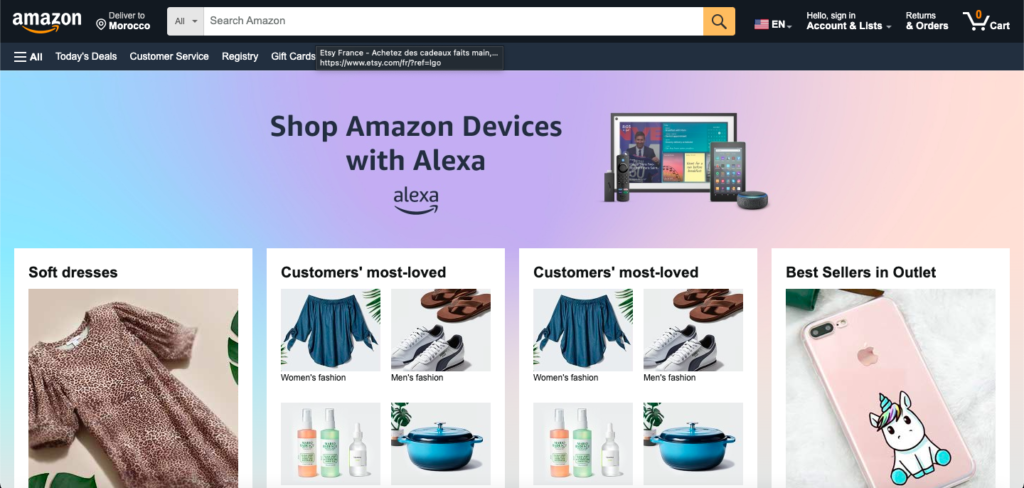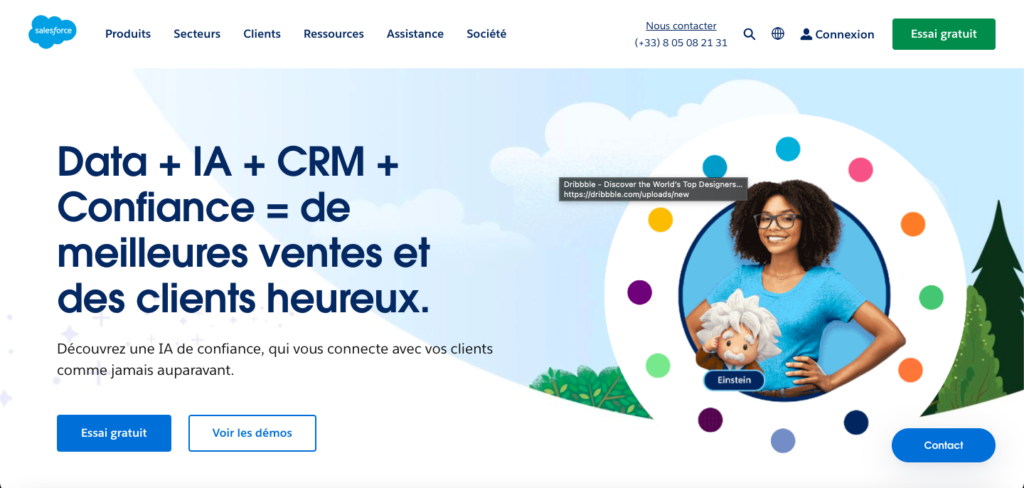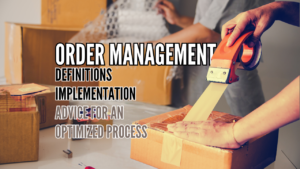
Do you have multiple business ideas but aren’t sure how to turn them into reality? Rest assured, you’re not alone. Indeed, the process of launching a business is often complex – there are many steps to follow, and it’s not always easy to know where to begin.
This practical guide will provide the aspiring entrepreneur with all the tools and steps necessary to create their business. We explain the business formation procedures, the resources you’ll need, as well as the cost of this process.
What it takes to start a business
In this section, we present and explain everything you need to know to create your business, from developing the business idea to obtaining insurance coverage.
Idea of a business project
The success of a business begins with finding the right product or service to offer.
Start by identifying your strengths, skills, and interests. Try to pinpoint an industry where you might have an advantage. Finding a business idea that aligns with your passion will help you deliver a quality product while enjoying the process.
Suppose you love cooking or are skilled in that area. In that case, some profitable small business ideas include starting a catering business or a food franchise, publishing digital cookbooks, or creating an online cooking course.
You can also explore trending products. This approach ensures that there is promising market demand. You can use Google Trends to monitor interest in a product. For example, below are the Google Trends data showing the global search volume for the term “dog toy” over the past 12 months.
Another method is to visit the most popular online marketplace platforms to find the most in-demand items. For example, Amazon has a “Best Sellers” page that is updated hourly. This page showcases the top-performing products in various categories.

If you want to sell handmade items, check out Etsy. This online marketplace has a page dedicated to the best-selling items, which will give you ideas for profitable products to make and sell.
Finance, taxes and banks
In France, there are different tax regimes, such as the micro-enterprise regime, the simplified real regime, and the normal real regime, which determine the taxes you need to pay for your business.
Each of these regimes has its own rules and criteria. It is essential to understand which one applies to your business. The taxes your business may be subject to include corporate income tax (IS) or income tax (IR) for sole proprietorships, as well as value-added tax (VAT) for businesses subject to it.
Please consult an accountant or tax professional to help determine the specific taxes your business needs to pay based on its type and applicable tax regime.
In addition to the tax regime, it’s also crucial to have a fiscal identifier in France. This fiscal identifier is known as the SIREN number or SIRET number. It’s a unique number assigned to every business, whether small or large.
This number allows the tax authorities to identify you and properly handle your tax obligations. When setting up your business, you must register with the relevant authorities, such as the Center for Business Formalities (CFE) or Urssaf, to obtain your fiscal identifier.
It’s with this identifier that you’ll make your tax declarations, tax payments, and other tax-related formalities.
Make sure to keep your fiscal identifier in a safe place and have it readily available for any interactions with tax authorities. If in doubt or in need of further assistance, it’s advisable to contact the relevant tax services.
Licenses and permits
Licensing and authorization requirements for businesses and commercial activities can vary based on several criteria, such as the industry and the nature of the business.
In some cases, it may be necessary to obtain a professional license from the competent authorities, such as chambers of commerce and industry or chambers of commerce and crafts. These authorizations are often required for regulated professions, including sectors like real estate, agri-food, and healthcare.
Certain specific activities may even require special permits, such as restaurants wishing to sell alcoholic beverages or businesses handling hazardous chemicals. In these cases, it’s important to obtain the appropriate authorizations from the relevant authorities, such as prefectures or specific professional organizations.
It’s worth noting that licensing and permit requirements can vary depending on the industry, geographic location, and specific regulations related to each profession. To obtain accurate and up-to-date information on the licenses and authorizations required for your business activities in France, it is recommended to directly contact the competent authorities, such as chambers of commerce and industry, chambers of commerce and crafts, prefectures, or relevant professional organizations.
Regulations and requirements regarding licenses and authorizations can evolve over time and vary based on the geographic location of the business and other characteristics. That’s why it’s mandatory to reach out to the relevant authorities to obtain precise information in this regard.
Software and hardware
Running a business requires a lot of work, but fortunately, there are various software and tools available to automate business processes. Here are some types of software you might need to manage a small business:
- Accounting: Use accounting software to streamline financial activities like tracking cash flows and preparing financial statements. Examples include QuickBooks and FreshBooks.
- Project Management: Project management software allows you to plan and execute projects. You can schedule tasks, allocate resources, track progress, and collaborate with team members. Examples include ClickUp and Monday.com.
- Payroll: Before hiring employees, set up payroll software. Payroll service providers can automate the employee payment process and help you comply with wage laws. Examples include Gusto and Paychex.
- Taxes: Understanding various taxes can be confusing. Tax software can assist you in preparing and filing taxes. Examples include TaxAct and TurboTax.
- Customer Relationship Management (CRM): CRM software enables you to enhance customer satisfaction. It helps manage customer relationships, track business analytics, and automate marketing and customer service. Examples include Salesforce and Keap.

Many of these platforms often have overlapping features. For example, if your CRM software already integrates business analytics tools, you might not need a separate application for tracking sales data. Therefore, it’s important to assess your needs and carefully analyze the features of each software.
If you plan to open a physical store, you may need a Point of Sale (POS) system. A POS system is hardware used for processing card payments. Nowadays, there are also mobile-based POS systems available. Clover and Vend are examples of POS system providers.
Business insurance
Without adequate insurance, you risk going bankrupt due to unexpected disasters like natural calamities, accidents, or lawsuits. That’s why it’s essential to find the right insurance coverage to protect your business and personal assets.
Some businesses may even be legally required to have specific types of commercial insurance. For instance, companies with employees may need to provide workers’ compensation, unemployment, and disability insurance to comply with federal regulations.
As with other legal requirements, business insurance laws vary from state to state, so be sure to check your local government’s website for the most up-to-date information.
Purchasing legally required insurance is the bare minimum. You can also consider various types of insurance to cover other risks associated with your business. Here are some examples:
- General liability insurance for all types of businesses.
- Product liability insurance for companies selling products.
- Professional liability insurance for businesses providing professional services.
- Commercial property insurance for companies with significant physical assets.
- Home-based business insurance for small businesses operating from the owner’s home.
- Business owner’s insurance for most small business owners.
Additionally, consider exploring retirement and health insurance plans for yourself and your employees.
After assessing your risks, look for reputable and licensed insurance agents. Then, compare rates from multiple insurers to get the best deal.
Make sure to ensure expenses you cannot afford out of pocket. Also, don’t forget to reevaluate your business’s risks and insurance coverage needs annually, based on your company’s growth and responsibilities.
Steps to follow to start a business
In this section, we provide you with a step-by-step guide on how to create a business, from preparing a business plan to developing effective marketing strategies.
1. Write a business plan
Once you have a general idea of your business goals, it’s time to write a business plan. A solid business plan serves as a step-by-step guide for the business owner.
A typical business plan consists of the following elements:
- Executive Summary: Briefly explains the business goals and methods to achieve them.
- Company Description: Highlights the problems your business solves and what sets it apart from the competition.
- Market Analysis: Provides an industry overview, target audience profiles, and a competitive analysis.
- Organization and Team Management: Outlines your business’s structure, management hierarchy, and working principles.
- Product or Service Details: Describes the product, including how materials are sourced, who’s responsible for production, and its cost.
- Marketing Plan: Identifies appropriate marketing strategies to promote your product or service to potential customers.
- Financial Projections: Includes a budget and a list of projected financial statements, followed by a five-year financial plan.
When preparing a business plan, it’s important to be clear about the purpose and audience. Small businesses usually create a business plan to attract investors. Many business owners also use it to provide guidance to employees and potential collaborators.
Therefore, use clear and concise language, and structure the plan to help the intended audience easily understand the information. If you need to provide more details, include an appendix instead of overloading the main content with data.
2. Carry out a market study
Market research is the process of gathering and analyzing information about a specific industry, including its profitability, trends, and market saturation.
There are two main types of market research: primary research and secondary research. Primary research involves analyzing data gathered from interviews, surveys, or focus group discussions. Secondary research involves studying publicly available information from research documents or statistics published by government agencies or other organizations.
Two important aspects to focus on during the research process are the niche within your industry and your competitors.
Operating within a niche can help you develop a more effective business strategy and reduce competition. For example, rather than selling generic food products, your business could focus on selling gluten-free products.
Use powerful search engine optimization (SEO) research tools, such as Google Trends or Ahrefs’ Keywords Explorer, to assess people’s interest in your niche or product idea.
Conducting a comprehensive market research also involves analyzing the competition, which will help you understand where your business stands within the industry. Gather information about your competitors’ strengths, weaknesses, products, unique qualities, target audience, and business strategies. Tools such as iSpionage and Sprout Social are helpful for researching competitors.
3. Identify your target market
Understanding your target market is essential before creating your business. It refers to the group of consumers you plan to market your products and services to. Knowing your target audience will help you develop more effective advertising campaigns and establish trust between your brand and your customers.
Identifying your target audience is a crucial part of conducting a comprehensive market study. Collect data from potential customers through surveys or interviews. You can also analyze the types of consumers that your competitors are addressing, as they may be similar to those you are targeting.
Next, create personas to better understand the general demographic characteristics of your target market. A persona is a fictional character representing the ideal customer for your business. Factors to consider when creating personas include age, location, gender, income, occupation, and interests.
Develop a few personas and adapt them as you gather information through your research and business management. This will give you a more precise idea of your target market. In many cases, you may need to create new personas over time due to significant changes in the industry or market demand.
4. Choose a business name
Studies show that 77% of customers refer to certain products by their brand name. Therefore, it’s crucial to find an appropriate business name to enhance the company’s brand image.
Start by defining the vision, values, and personality of your business. Then, brainstorm names around these terms by:
- Researching relevant keywords.
- Using a search engine to find unique words and their meanings.
- Drawing inspiration from literature and mythology.
- Incorporating your own name into the brand.
- Utilizing a business name generator.
Regardless of the method you choose, make sure the name is easy to spell, memorable, and relevant to your business.
After finding the preferred business name, check if it’s available as a website domain name to maintain consistency across all your marketing platforms. Use a domain name checker, search the name in the official trademark database, and see if it’s available for use on your social media accounts as well.
Finally, don’t forget to register your business name. In the United States, there are four main ways to register your business name:
- Entity Name: Registering your business entity name provides state-level protection. Depending on your business structure and location, the state may require business owners to file for this registration.
- Trademark: This type of registration protects your brand at the national level. Registering a trademark prevents other businesses from using your company name.
- Doing Business As (DBA): Also known as a trade name, fictitious name, or assumed name, a DBA does not technically offer legal status protection. However, the law may require you to register one.
- Domain Name: Purchasing a domain name secures your business website’s address. This prevents others from using your registered domain as long as you own it.
5. Choose a legal status
In this section, we will focus on the most common business structures. Keep in mind that business structures can vary depending on the location of your business, so conducting appropriate research is essential.
There are four common business structures: sole proprietorship, partnership, limited liability company (LLC), and corporation.
- Sole Proprietorship:
A sole proprietorship is a business entity in which a single individual owns and manages the business. The sole owner can use their personal name as the business name or operate the business under a different name by filing a Doing Business As (DBA) registration.
Since there is no legal separation between the owner and the business, the sole owner is personally responsible for the debts and obligations of the business. Obtaining small business loans from banks or financial institutions can be challenging because most creditors prefer to work with well-established businesses with clear credit histories.
- Partnership:
A partnership is a business structure in which two or more individuals jointly own and operate a business. There are two main types of partnerships: general partnership (GP) and limited partnership (LP).
General partnerships consist of at least one general partner with unlimited liability and at least one limited partner with limited liability for the debts and losses of the business. The general partner conducts business activities, while the limited partner serves as a silent partner or investor. In contrast, all members of an LLC have limited liability and can participate in business decisions.
- Limited Liability Company (LLC):
An LLC is a business structure that shields the owner from personal liability, meaning their personal assets are not at risk in case of business bankruptcy. LLCs are not subject to corporate income tax, but members are treated as self-employed individuals and must pay self-employment tax.
Most states do not limit the number of members in an LLC. Members can include individuals, corporations, and even other LLCs. Many states also permit single-member LLCs.
- Corporation:
A corporation is a legal entity distinct from its owners. It can generate profits, pay taxes, and be held accountable. This legal structure provides the highest level of protection against personal legal liability. However, it can be quite costly to establish and maintain.
By default, a corporation is taxed as a C Corporation according to IRS rules, which can lead to double taxation. However, some corporations can elect S Corporation status, allowing them to avoid corporate income tax while subject to additional regulations regarding business ownership and stock categories.
6. Perform a break-even analysis
The analysis of the break-even point helps calculate the number of items a business must sell to cover all its startup expenses. This is known as the break-even point, the point where the total cost of production and operation equals the total revenue.
This calculation is crucial for attracting investors or securing a loan to finance your business. Additionally, break-even analysis helps set product prices, mitigate financial risks, and establish sales goals.
The formula to calculate the break-even point is as follows: fixed costs divided by the average selling price minus variable costs. You can also use a break-even calculator to assist in the analysis.
Let’s assume you plan to sell vegetarian meals and have determined that the break-even point needs to be reached:
- Startup costs amount to $500.
- Variable costs are $2 per meal.
- The selling price per meal is $10.
The formula would be: $500 / ($10 – $2) = 62.5. This means you need to sell at least 63 units to cover your startup expenses. Selling more than that would result in a profit.
7. Create a marketing plan
Before starting to sell, create a detailed plan outlining how you will market your products and services to potential customers.
Typically, a marketing plan includes information such as:
A summary of the overall marketing plan. The company’s vision, mission, and objectives. Elements of the company’s brand, such as the logo, colors, fonts, and the company’s voice and tone. Data about the industry, competitors, and the target market. The company’s budget plan. However, the marketing plan should primarily focus on marketing channels and strategies. Here are some marketing methods to promote your business and products:
Social media marketing: Create high-quality content on social media, publish it regularly, and encourage engagement by interacting with your followers. You can also run ads on social platforms using tools like Facebook Ads Manager and Twitter Ads.
Influencer collaboration: Collaborate with influencers, either by paying them to promote your products or by sending them products to review. Influencers have the power to influence their audience’s purchasing decisions and can turn them into customers.
Email marketing: Build a list of potential customer email addresses. Use email marketing automation tools like Mailchimp and Constant Contact to inform your customers about new product releases, special offers, or updates about your store.
Paid search advertising: This marketing strategy involves paying search engines like Google to place ads at the top of search engine results pages. Google Ads is a popular platform for this type of advertising.
Giveaways and contests: These promotional events can be organized both online and offline to create awareness for your new business. Encourage people to participate by sharing an article about your products or responding to surveys. To create online giveaways and contests, use tools like Woorise and SweepWidget.
Don’t forget to monitor the performance of your marketing efforts to determine what works and what doesn’t, and adjust your strategies accordingly.
8. Consider franchising
If starting your own business seems too intimidating, buying and opening a franchise from an established company can be an alternative. Some of the most popular franchises include McDonald’s, 7-Eleven, and Taco Bell.
In addition to a well-established business model and brand popularity, the franchisor will provide training guidelines and standardized operational procedures. As a franchisee, all you need to do is find a location for your store, secure financing, and hire employees. Purchasing a franchise can sometimes be less expensive than starting your own business.
However, opening a franchise comes with many conditions. By signing a franchise agreement, you are obligated to follow the franchisor’s instructions on how to operate the business. You also need to share profits with the franchisor. Furthermore, franchisors may choose not to renew the franchise agreement when it expires.
Keep in mind that franchising doesn’t guarantee success. Like any other business, you need to work hard and implement good business practices to achieve favorable results.
How much does it cost to start a business?
Starting a business can cost anywhere from a few thousand to hundreds of thousands of dollars. It all depends on the type of business and how it is funded.
Review your financing options
When it comes to finding capital to cover business costs, 77% of small business owners use their personal savings. This option allows them to avoid the pressure of investors and the expectation of immediate profit growth.
However, seeking external funding is often a better way to quickly grow a business. Here are five sources of external financing to consider:
- Crowdfunding: Raise funds by inviting people to finance your new business, either through your personal network or crowdfunding platforms like Indiegogo and GoFundMe.
- Small Business Loans: Banks can offer commercial loans ranging from $5,000 to $500,000 with an average interest rate of 3.19% to 6.78%, depending on the startup’s situation.
- Venture Capital (VC): Venture capital firms like Sequoia Capital and Accel raise funds from wealthy investors, financial institutions, and investment banks. They then evaluate potentially profitable businesses for funding.
- Angel Investment: Compared to venture capital, this option may be easier for early-stage small businesses to obtain. Angel investors use their own money, and it’s up to them to choose which business they want to invest in.
- Government Programs: Unlike the previous options, many government funding programs do not require businesses to repay the money. However, it takes time to find an appropriate program, as many small business grants only fund specific industries or business owners, such as veterans or disadvantaged entrepreneurs.
How to start a business without capital
It is possible to create a business with little to no money. However, you generally need access to the internet, either through a computer or mobile device. Additionally, you won’t require a significant capital investment, but rather your time and skills.
Here are some business ideas you can start with little or no money:
- Remote Work: Make money online by turning your skills into remote work. You can become a virtual assistant, freelance writer, data entry specialist, translator, or offer social media marketing services. Look for remote freelance jobs on platforms like Upwork and Fiverr.
- Offer Simple Services: Your time is your most valuable asset, as it involves performing small tasks for people who either don’t want to do them or are too busy. This can include house-sitting, dog walking, cleaning, grocery shopping, or car washing.
- Selling Digital Products: Start an online business by creating and selling digital products using a simple computer. Ebooks, design templates, and online courses are examples of products you can sell online.
- Print-on-Demand Business: Create designs and let print-on-demand companies like Printful and Printify handle the rest. When a customer orders a product featuring your design, the company prints the design on the item and ships it to the buyer. You only pay a commission to the company after the customer has paid you.
- Dropshipping: Similar to print-on-demand, this model allows you to sell products without managing inventory. Find suppliers on platforms like SaleHoo and Spocket and let them fulfill orders. You then share the profits with them.
The next steps in creating your business
The following sections describe other steps you can take to help your business succeed.
Recruit an exceptional team
Many businesses fail due to poor management, which is why considering getting help when starting a business is essential. Managing all the responsibilities associated with running a business can be overwhelming.
Smart business owners have the foresight to outsource tasks they either don’t have the time or skills to perform, especially as the workload increases with business growth.
Before hiring employees, you need to consider the time and expenses required for recruiting and onboarding new team members. Here’s a step-by-step guide on how to hire employees:
- Evaluate the types of positions you need to fill.
- Develop a recruitment strategy.
- Post job listings on job search websites like Indeed and ZipRecruiter.
- Review applications.
- Conduct interviews with qualified candidates.
- Check the backgrounds of potential employees.
- Extend job offers to the top candidates.
- Implement an onboarding process for new employees.
The types of positions to be filled can vary from one business to another. However, the most common positions include a marketing specialist, a graphic designer, a social media manager, and a stock manager. Additionally, you can hire remote workers for positions that do not require working in a physical store or office.
Create a website
Knowing how to create a website for your business is a necessity in this digital age. Studies show that over 70% of small businesses have a website. If you’re running a business without a website, you’ll find it more challenging to compete with the vast majority of businesses that have established their online presence.
Moreover, small business statistics reveal that up to 80% of consumers conduct online research about a business before making purchases or visiting a store. So, creating a website reduces the risk of losing potential customers to other brands.
There are two types of platforms for creating your business website or online store: hosted or self-hosted.
Opting for a hosted platform means creating a website using a website builder that also provides web hosting. Examples of these are Hostinger’s Website Builder, Wix, and Squarespace.
We recommend Hostinger’s Website Builder due to its powerful AI tools that can assist with various website creation and design tasks. For those looking to create a website to sell products online, Hostinger offers an e-commerce website builder along with hosting.
Choosing a self-hosted platform means setting up your own web hosting with the assistance of a web hosting provider and creating your website using a Content Management System (CMS). Popular examples of CMS platforms are WordPress, PrestaShop, and Drupal.
The learning curve for a CMS is steeper than that of a website builder, but it gives you more control over your website in terms of design, SEO, and scalability. That’s why we recommend going for self-hosting.
Get a hosting plan and domain name
If you’re creating a website using a self-hosted platform, you’ll need to purchase a hosting plan and a domain name.
Web hosting is an online service that allows you to store your website’s data, while the domain name will be your website’s address – the URL that users type into their browser to access your site.
There are various types of hosting services, so it’s important to choose the web hosting plan that suits your needs. For instance, people creating a website for a small business might opt for a shared hosting plan. On the other hand, website owners expecting significant traffic might choose cloud hosting for better performance.

Some web hosting providers even offer hosting plans tailored for specific content management systems (CMS). For example, at Hostinger, you can find hosting plans designed for WordPress. Another popular service is PrestaShop hosting.
Many companies also include free domain names for websites as part of their hosting plans, which can help you save money when creating your website.
Conclusion
Almost anyone can start a business these days. You just need to come up with a business idea and take care of the financial and legal aspects. Then, you’ll have to consider the software and hardware you need to run the business and get insurance coverage.
To help you get organized, here’s a summary of the steps for starting a business:
- Write a business plan.
- Conduct market research.
- Define your target market.
- Choose a business name.
- Select a business structure.
- Perform a break-even analysis.
- Develop a marketing plan.
- Consider franchising.
Once your basic business plan is in place, think about hiring employees and creating a website or an online store. To finance the business, consider options like crowdfunding, loans, investors, and government grants.
If you want to start a business without raising capital, you can consider working remotely, offering simple services, selling digital products, dropshipping, or creating an on-demand print business.
We hope this article has provided you with insights on how to start a business. If you’ve embarked on starting a business, we’d love to hear about your experience in the comments section below.





